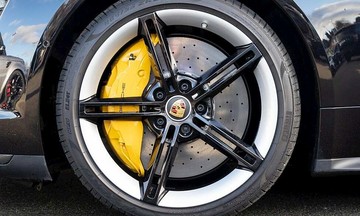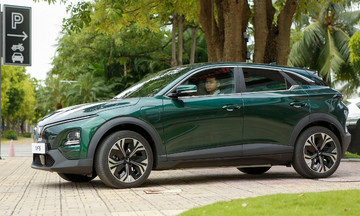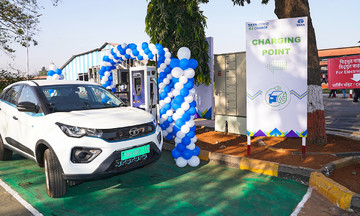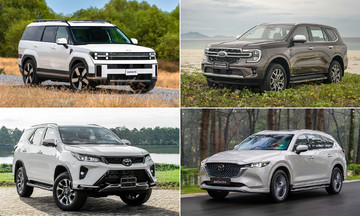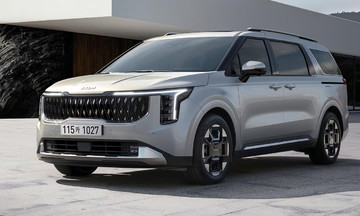According to Motorcycles Data, Vietnam was the third-largest electric motorbike market globally in the first half of 2025. Demand is projected to grow as established manufacturers enter the electric vehicle market. Additionally, Hanoi and Ho Chi Minh City plan to restrict gasoline-powered motorbikes in certain areas.
As with electric cars, charging access is a major consideration for potential electric motorbike buyers. Currently, few companies invest in public charging stations for motorbikes, and the number of stations is significantly lower than for cars.
Who needs public charging stations?
Minh Quan, 32, from Ho Chi Minh City, has owned a VinFast Evo200 for about two years. He rarely uses VinFast's public charging stations, relying instead on outlets in his apartment building for his daily 40-50 km commute within the city. VinFast claims the Evo200 has a range of approximately 200 km per charge.
Quoc Huy, 29, also from Ho Chi Minh City, and also an Evo200 owner, uses public charging stations daily. "I travel 150-200 km or more each day transporting passengers. I charge whenever I have a meal break or the battery is low, using any convenient station," Huy said. He frequents charging stations at shopping malls and cafes, a growing trend.
 |
An electric motorbike owner charges their vehicle at a shopping mall in Ho Chi Minh City. Photo: Thanh Nhan |
An electric motorbike owner charges their vehicle at a shopping mall in Ho Chi Minh City. Photo: Thanh Nhan
While both own electric motorbikes, their daily mileage dictates their differing needs for public charging stations. Manufacturers, too, must consider customer usage when deciding whether to invest in public charging infrastructure.
"Most electric motorbike owners charge at home if their daily usage is low," said Phuoc Nguyen, CEO of Selex Motors. "Public charging stations are essential only for those who travel hundreds of kilometers daily, typically delivery drivers or passenger transport providers."
Nguyen explained that motorbikes, being compact with smaller batteries, can easily be charged overnight at home. Cars, on the other hand, are larger, have bigger batteries, and not all owners have the space for home charging. Therefore, public charging stations are more crucial for cars than motorbikes.
A manager at a charging network company in Vietnam agreed. Electric motorbike batteries are designed for standard household outlets, allowing most owners to charge at home. However, public charging is essential for commercial drivers who require continuous operation.
Many apartment buildings restrict car charging due to space or electrical system concerns, forcing car owners to rely on public stations. In contrast, numerous residences provide designated charging areas specifically for electric motorbikes.
Public charging models in Vietnam
Most electric motorbike manufacturers in Vietnam encourage home charging. Only a few, like VinFast, Dat Bike, and Selex Motor, offer public charging, but on vastly different scales.
V-Green, VinFast's charging infrastructure developer, claims to operate over 150,000 charging ports for both motorbikes and cars nationwide, the most in Vietnam. However, the company hasn't specified how many are for motorbikes. VinFast's motorbike charging stations are primarily located at Vincom shopping malls.
Observations at Vincom malls in Ho Chi Minh City reveal few individual users charging there. Most are ride-hailing drivers. Private owners typically charge at home, only using public stations when visiting these malls for leisure.
Selex Motor focuses on commercial users in Vietnam. The Camel 1 targets individual customers and delivery businesses, while the Camel 2 is designed for passenger transport.
 |
A driver swaps batteries at a Selex station in Hanoi. Photo: Selex Motor |
A driver swaps batteries at a Selex station in Hanoi. Photo: Selex Motor
Selex Motor opted for battery swapping stations over traditional charging. Drivers can quickly exchange depleted batteries for fully charged ones, a model considered optimal for electric motorbike users by experts. Selex Motor is currently the only company implementing this model in Vietnam. TMT recently announced plans to launch 5 electric motorbike models in late 2025 with a similar battery swapping system.
Battery swapping stations are already prevalent in markets like Taiwan and India due to their speed and convenience, as charging typically takes from several minutes to hours. Honda also supports this model with removable batteries compatible across various models.
In 8/2022, Dat Bike launched its first super-fast charging station in Ho Chi Minh City, offering a 20-minute charge for a 100 km range. The company initially planned expansion, but after receiving customer feedback, halted further development of these stations.
Dat Bike stated that the demand for public charging among daily commuters wasn't sufficient to warrant further investment. The brand now focuses on partnering with individuals and businesses to expand charging access.
Among dedicated charging station providers, the number of stations for motorbikes is significantly fewer than for cars. Eboost is currently the only provider offering installation and equipment for electric motorbike charging stations, but the number remains negligible.
 |
An electric motorbike charging station combined with a cafe in Ho Chi Minh City. Photo: Pham Trung |
An electric motorbike charging station combined with a cafe in Ho Chi Minh City. Photo: Pham Trung
Vietnam's electric motorbike market has grown considerably in the last two years, driven largely by commercial users seeking lower operating costs compared to gasoline-powered bikes. With manufacturer-provided charging stations insufficient to meet this demand, many individuals have invested in charging stations combined with repair services, cafes, and rest stops for electric motorbike users.
Cong Thanh, owner of an electric motorbike charging station in Tam Binh ward, Ho Chi Minh City, has been operating for over a year. "Most of my customers are ride-hailing drivers. They typically stop by for a meal and rest for 1-2 hours while their bikes charge," he added.
Thanh Nhan






